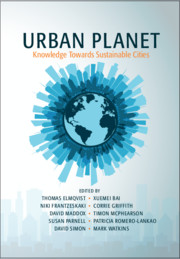How can twenty-first century cities sustain life if urban ecosystems, waters, and local residents are not prioritized in urban planning and design? High-tech solutions, disconnected from local natural processes, flows, and climate, are leading people to believe that sustainability is dissociated from nature. I would like to understand what sustainability means when a glass-covered building surrounded by a cosmetic garden, detached from the local culture and environment, receives a green certification.
In a society focused on financial capital, cities must be global in order to be part of the economic system and to attract international investment. So, how does a city become a “global city”? How can a city have a marketable brand recognized in this competitive world? The global city needs an “image” (Jhally Reference Jhally, Dines and Humez1990), generally represented by iconic architecture, and will thus become an image-based city. The image has become more important than substance at all scales, from the individual to the urban landscape. The image is created by outside drivers, market agents that focus on the most profitable and the fastest economic return. This exogenous force doesn’t make any real compromises for long-term social and ecological sustainability; it is fluid, and flows with the winds of opportunity. The turns are fast and unpredictable. Frequently, politicians concentrate on the next election and their need for more money. It is easy to understand why decisions are made to invest public money in expensive works of engineering. Corruption is a key issue in this process.
The city I live in, Rio de Janeiro, is a good example. As host of the 2016 Olympic Games, the “Marvellous City” went through a structural transformation according to the values of an image-based society in search of a higher global position. Huge, disconnected, top-down public-financed projects were made to comply with short-term private economic interests. For example, the city has built iconic, image-based, green architecture – such as the Museum of Tomorrow – while its cultural and historic heritage is left to ruin. Likewise, Rio’s ecological heritage has been damaged – urban sprawl took over wetlands vulnerable to flooding and sea-level rise through the construction of car-dependent, costly infrastructure and gated communities, perpetuating the mistakes of the past. The focus in this period was doing business as usual: building a marketable city while overlooking its natural, social, and cultural potential.
I strongly believe that cities should mimic nature and should systemically restore socioecological functions that sustain life and protect the environment. Life is our most precious capital to achieve real sustainability. We should enter a life-based society, where cities are planned and designed to provide hospitable and liveable environments for people and biodiversity. Economic forces should come from the communities; local potential should be the foundation for sustainable development. The buildings that shape the urban landscape should provide regenerative functions, such as green roofs, walls, and rain gardens that mitigate the urban heat island effect and prevent floods. Investments should incentivize comfortable, safe, and healthy housing for everyone. The economy and real estate development should be based on local and small and medium businesses, minimizing the turns of international economic flows.
Once we know that sustainability depends on ecological, social, and economic factors, what is missing? Ecological education and urban greening may be the bridge to a liveable future in sustainable cities. The challenges are many, but if urbanites don’t have the opportunity to experience and learn about nature, they won’t understand why they need nature or clean air and water to have healthy lives. They also won’t collaborate to change the urban landscape. Educated and participative citizens are crucial in the process of legally control corruption, and monitor investments that will benefit the commons.
Life-based society is only possible if corruption is controlled; otherwise people’s interest won’t be prioritized, and participation will merely be a legal requirement to legitimate top-down decisions.
Being a green city is also a marketing strategy. Investing in soft-engineered green infrastructure (nature-based solutions – NBS), instead of traditionally built gray infrastructure, is essential. This is not new; however, in order to provide an effective long-term return, the greening of the city has to be genuine – supported by inherent social, cultural, and ecological capacities.
The paradigm shift to life-based society is already happening in many cities. For example, Paris is leading the way in promoting and recovering urban biodiversity (Legenne et al. Reference Legenne, Cornet, Acerbi and Tedesco2015), and focuses on people and local businesses. Cars are gradually being removed from the urban landscape to prioritize people and green areas. The city has a comprehensive plan to mitigate carbon emissions and to adapt to climate change (PARIS 2012). Effective participation and ecological education have been essential to shift from the image-based city to a life-based city. No doubt, the city faces strong social challenges; justice is a complex issue that also depends on external forces. But Paris – the City of Light – is becoming the City of Life: greener, attractive, liveable, sustainable, and resilient.



